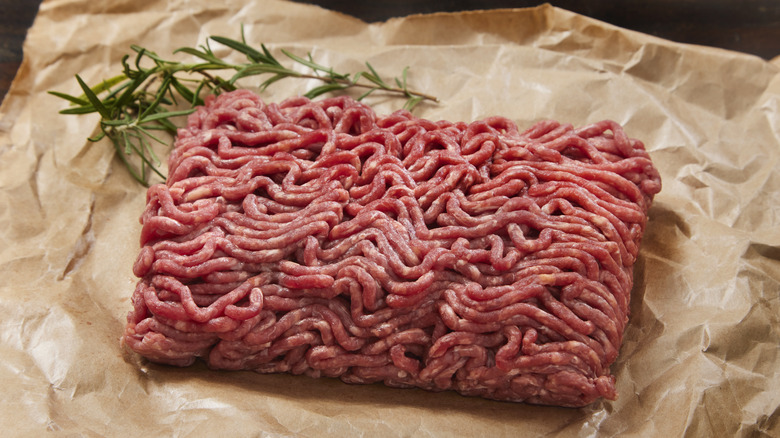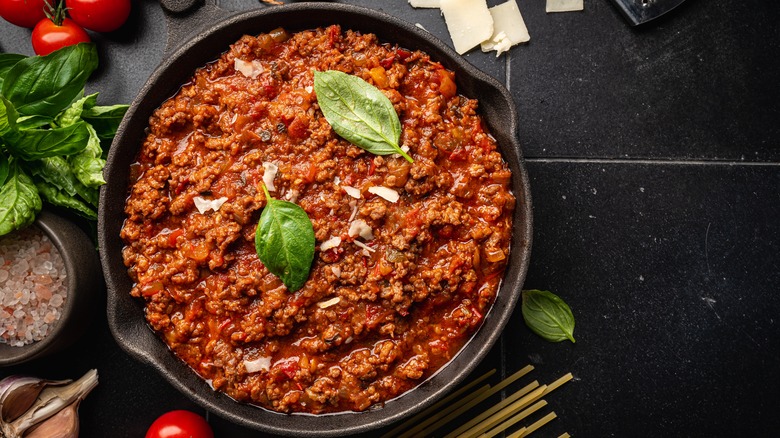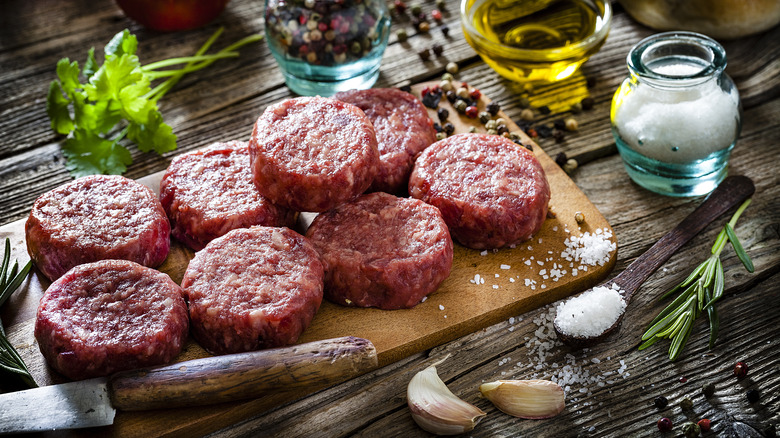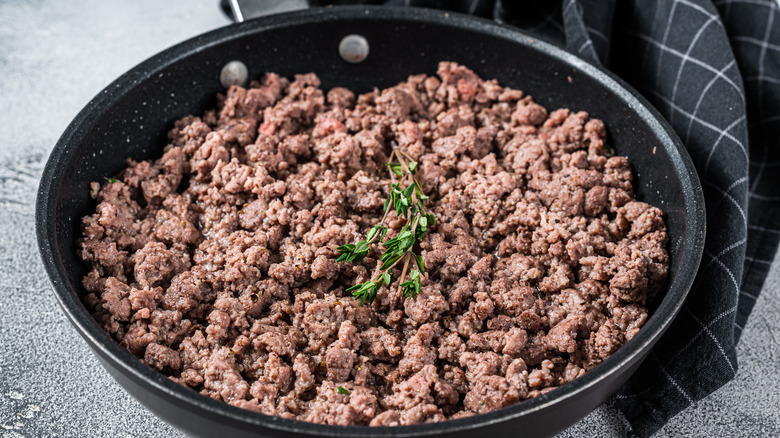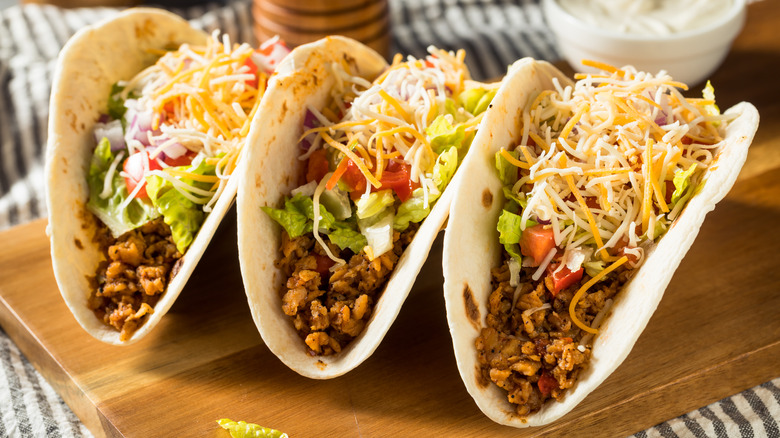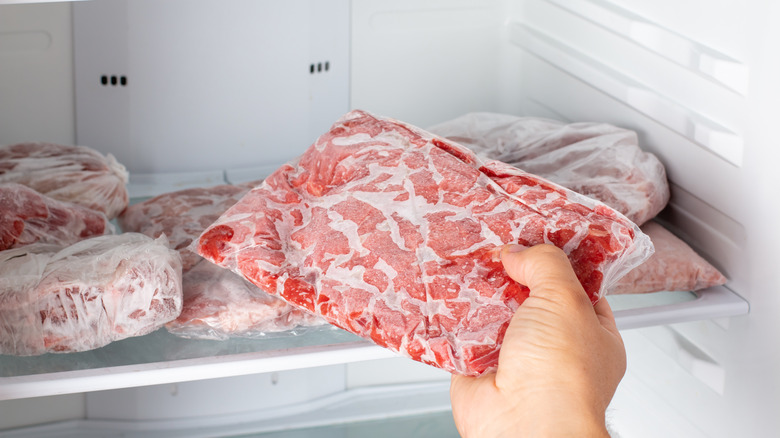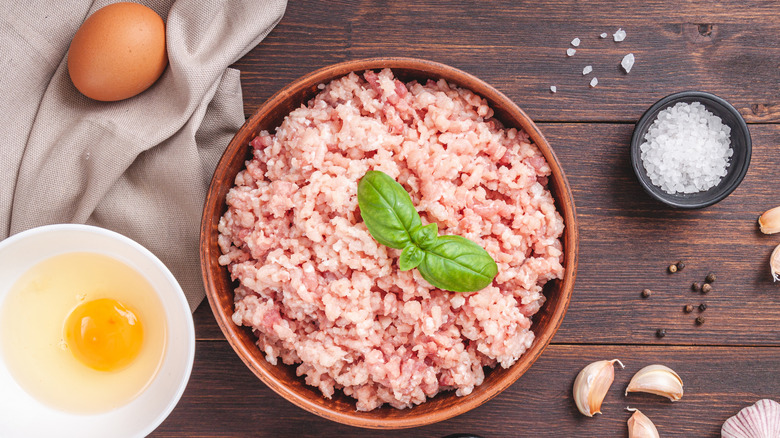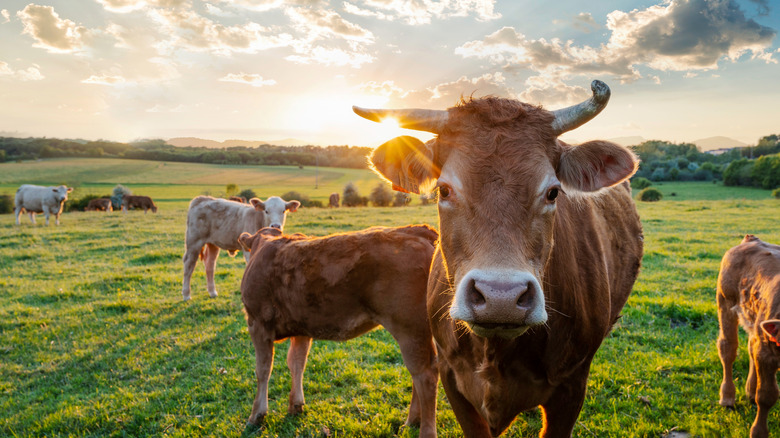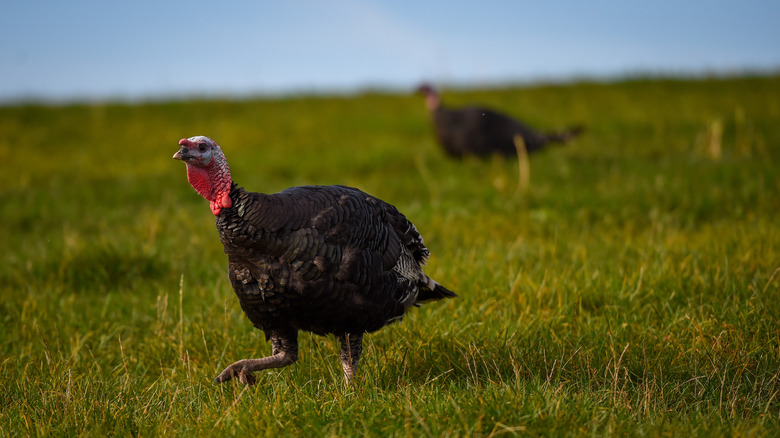Ground Beef Vs. Ground Turkey: Which Is Healthier?
Ground meat is a great addition to many healthy diets. Not only is it high in protein and low in calories, but it's also endlessly versatile when it comes to cooking. So long as you don't lace it with sugar-laden barbecue sauces or excess fats, you can plan an entire week of healthy dinners. Think tacos, meatballs, meatloaf, burgers, and bolognese. Or whip up enchiladas, lettuce cups, sloppy joes, or a big batch of your famous chili. Ground meat is your gateway to a multitude of tasty classics with a health-conscious slant.
Ground beef and turkey are two of the most popular choices, but which is the healthier option? Today, we'll unravel this meaty mystery and find out which meat reigns supreme when it comes to nutrition. Using hands-on experience and peer-reviewed studies, we're going to dive deep into the nutritional aspects of ground beef and ground turkey. We'll explore their fat content, protein levels, and essential nutrients, all the while keeping your health-conscious goals in mind. We'll also break down the differences in flavor and texture, so you'll know what to expect when they hit the pan.
Ground turkey has fewer calories
Ground beef and turkey come with varying levels of fat content. The health edge that turkey has over beef is that ground turkey can be 99% fat-free. This doesn't mean that it is calorie-free; a 3-ounce portion of this type of ground turkey clocks in at 117 calories. Compare this to super-lean ground beef with a fat content of 5%, which clocks in at 164 calories per 3-ounce serving. With those numbers, both options are a great choice for any low-calorie diet.
Calories are vital for our survival, and essentially, they are a measurement of energy. We get calories from carbohydrates, protein, and fats, and calories fuel our bodies with energy when they are broken down in our stomachs. As WebMD explains, the average male aged 19 to 30 with a moderately active lifestyle requires roughly 2,400 to 2,600 calories per day, while the average female with the same statistics requires roughly 2,000 to 2,200 calories. Keeping our beef and turkey numbers in mind, we can see that both options are a great choice for staying within these recommended daily calorie levels, but turkey is the winner.
Ground beef has more protein
Protein has become a health buzzword in recent years. Many gym goers track their daily protein count and supplement their levels with protein bars and shakes to fit in with today's on-the-go lifestyle. Meat is still one of the best sources of protein, and ground beef is the slim winner in today's head-to-head competition. A comparative look at a 3-ounce portion of ground beef and turkey with a 93/7 percent ratio of meat-to-fat content reveals a 2-gram protein difference. The ground beef clocks in at 25 grams of protein compared to the turkey's 23 grams.
So it's a slight win for ground beef, but when it comes to protein, every gram counts. Protein is one of the essential macronutrients for our body. It's the foundation upon which healthy bodies are built, and every cell in your body contains protein. Without it, your body would not be able to create new cells or repair damaged ones. So how much protein should you consume in a day? Well, this varies from person to person depending on your age, activity level, and overall health, but the U.S. Food and Drug Administration recommends 50 grams per day.
Ground turkey is better for your heart
The American Heart Association reports that the four types of fats in our daily diet are monounsaturated, polyunsaturated, saturated, and trans fats. The latter two, saturated and trans fats, are considered unhealthy fats that should be consumed in moderation. The good news for turkey lovers is that ground turkey is lower in saturated fat than our beefy competitor. A 3-ounce portion of both ground meats with an 85/15 percent ratio of meat-to-fat content has a 1-gram difference in saturated fat. Ground turkey clocks in at 3.9 grams, followed by ground beef at 4.9 grams. A gram may not seem like much, but if you're watching your saturated fat intake, it could make or break a meal. Ground turkey also has a 99% fat-free option, which comes in at 0.57 grams of saturated fat per 3-ounce serving.
A balanced diet should contain a moderate amount of fat. It gives us energy, protects our organs, enables us to absorb nutrients, and helps our bodies create essential hormones. However, too much of the bad fats, saturated and trans fats, can raise our low-density lipoprotein, otherwise known as bad cholesterol. High levels of bad cholesterol in your blood put you at greater risk for heart disease. The American Heart Association recommends around 13 grams of saturated fat per day.
Ground beef wins the cholesterol competition
Cholesterol is a complex subject, but the key thing to know is that there are two types: LDL and HDL, as well as triglycerides (via The American Heart Association). LDL, or low-density lipoprotein, is the bad type, and HDL, or high-density lipoprotein, is the good type. Cholesterol is a fatty, waxy substance in your blood, and too much of the bad type creates buildup, which can lead to heart disease and stroke.
The battle for cholesterol can be determined by looking at fat content and types of fats. A 3-ounce portion of ground beef with a meat-to-fat ratio of 93/7 percent contains 8 grams of fat and 3.3 grams of saturated fat. An equal portion of 93/7 ground turkey clocks in at 12.4 grams of fat and 2.5 grams of saturated fat. This helps us to determine, as the University of Illinois Urbana-Champaign explains, that ground turkey contains more cholesterol than ground beef.
Each ground meat is packed with vitamins and minerals
For this round, we have our first tie, and we're not even mad because, in reality, everyone is a winner. Some say that meat is the original superfood, and it's considered nutritionally complete (per Diagnosis Diet). This means it contains all the fat, protein, vitamins, and minerals that our bodies need in order to function properly. Both beef and turkey contain B vitamins, as well as iron, zinc, and more. This makes meat a nutritional powerhouse and the cornerstone of many diets.
Unfortunately, research (via Familydoctor.org) suggests that most Americans don't get enough vitamins and minerals daily. This could be due to the rise of ultra-processed foods. According to The Conversation, some research states that in the United States, Canada, and the United Kingdom, processed foods take up around half of the food people eat. A well-balanced diet is one of the best ways to get most of the vitamins and minerals you need. The FDA recommends a balanced diet of whole foods that contain protein, dairy, fruits, vegetables, and grains.
Both meats are offered in a range of meat-to-fat ratios
According to Meat Grinder Help, the meat grinder was invented in the 19th century by a German fellow named Karl Drias. It was a game-changer for butchers that not only saved them time but also gave them a new product to sell. All the excess trim from the primal cuts was ground into what we know now as ground beef. It was quicker than mincing by hand and ground meat that could be sold at a cheaper price.
Nowadays, ground beef comes in various meat-to-fat ratios, like 93/7 or 85/15. Butchers regulate the amount of fat in the meat by choosing the correct cuts. Ground beef can be a combination of cuts or be ground from a single cut. Super-lean ground beef is often ground from sirloin due to its lower fat content. Burgers often have an 80/20 or even 70/30 ratio of meat to fat to keep them juicy while cooking. Ground turkey also comes with a meat-to-fat ratio of 93/7, 85/15, and a fat-free option. Most ground turkey is made from legs and thighs, while the 99% fat-free option is ground from the breast.
Ground beef wins the taste test
To keep our test as simple and even as possible, we compared 93/7 ground beef and turkey. Each meat was cooked with a little neutral oil and seasoned with salt and pepper. The key to cooking ground meat is to start with a cast iron skillet over medium-high heat. Heat the oil, then add the meat. As the meat cooks, it will release moisture. The key is to let the moisture cook out completely, because only then will the meat start to fry in its fat and brown. As the meat browns, it caramelizes and develops aromas and flavors.
A side-by-side comparison reveals that the beef has a much more intense aroma than the turkey. It smells rich and bold compared to the turkey's lighter smell. The scents follow the same conclusion on the palate, with the beef being a clear winner. The overall flavor of the beef is more intense and savory compared to turkey's lighter flavor profile. The beef fat also did a better job of keeping the meat moist and flavorful.
Ground beef takes the texture title
Meat grinders use various attachment plates to produce a coarse, medium, or fine grind. The size of the grind is determined by the product that the meat is destined to become. Burgers can be coarse or medium-ground. Sausage meat can be medium or finely ground, and most ground meat at the store is finely ground.
When cooked correctly, ground meat should break apart with ease and have a pleasant chew. If the meat is dry and springy, then chances are you've overcooked it. In the battle for texture, beef once again came out on top. The cooked meat was juicy, and the fat content coated the palate well without feeling greasy. The turkey was a close second, and while the meat was tender, ground turkey tends to dry out when overcooked. Keep this in mind the next time you're frying a batch. The FDA recommends cooking ground beef to 160 degrees Fahrenheit and ground turkey to 165 degrees Fahrenheit.
Both meats are great in a variety of dishes
Ground meat is a blank canvas for flavor and the base for many classic recipes. Whether you choose beef, turkey, or a combination of both, ground meat is a great addition to your weekly diet. Our top tip is to buy it in bulk and freeze it in portions so you always have it on hand.
The easiest way to thaw ground meat is to take it out the day before you want to use it and pop it in the fridge. The meat will slowly thaw over time and be ready to cook the next day. For a faster method, submerge the sealed package of meat in cold water. For an even faster method, use the microwave defrost function. Ground beef and turkey can be stored in the freezer for up to four months, according to FoodSafety.gov.
To get the most out of your ground meat, you must brown it correctly. Like Gordon Ramsay always says, according to Chef Gordon Ramsay Recipes: "If there's no color, there's no flavor." It's the first step in your flavor pyramid, so take your time with it. From there, you can use your perfectly caramelized meat for classic lasagna or a plate of beef nachos. Or shape the raw meat into patties for turkey burgers or a classic beef cheeseburger. Just remember to cook them hard and fast to get that perfect sear.
Turkey is best for diet, but beef is best for flavor
So we've learned that either ground beef or turkey is a solid base for any diet. The lean options are both great, but with its 99% fat-free option, turkey might be your best bet for a slightly healthier option. That said, it's hard to beat the flavor of ground beef. Since our bodies need a certain amount of fat, you'll have to decide which ground meat fits into your diet better. You could even use a combination of ground beef and 99% fat-free ground turkey to get the best of both worlds.
One thing to keep in mind is to watch what you add to your ground meat. If your ground turkey is tasting a little bland, you might be tempted to throw in some ketchup, barbecue sauce, or even a knob of butter. A little might be okay depending on your diet, but bottled sauces often contain a lot of sugar, and any additional fat will bump up the overall fat content, according to the British Heart Foundation. To make sure your ground turkey stays healthy while modifying it, opt for a spice mix like taco seasoning or add a little heat with a vinegar-based hot sauce.
Turkey and beef farming both impact the environment
Food production is in the spotlight more than ever these days. Consumers want to know where their food is coming from as well as the ethical and environmental implications of it. If you are trying to reduce the carbon footprint of your diet, then it pays to be informed about farming's impact on our environment. Unfortunately, cattle farming is responsible for around one-third of all greenhouse gas emissions.
The carbon footprint of turkey farming is significantly smaller due to modern turkey production. It requires less land, water, and energy. According to research by Carnegie Mellon University, enjoying a turkey for dinner — for example, during Thanksgiving — produces less greenhouse gas emissions than having a roast beef for the special meal. While turkey farming may be less harmful to the environment than beef, it still has the fifth highest carbon footprint after lamb, beef, cheese, and pork.
Animal welfare in the beef and turkey industries
The success of retailers like Whole Foods Market, with a commitment to organic produce, means animal welfare gets more attention these days than ever before. Consumers are voting with their wallets, and while farming practices have improved, there is still work to be done — especially within the beef industry. Many of the cows raised for meat spend their lives in the crowded living conditions that exist at factory farms.
Turkey farming in the U.S. is also a big business. There were around 210 million turkeys reared in 2022. Unfortunately, most turkey farming is often confined to large barns, where conditions can be crowded. These cramped conditions can lead to health problems and injuries. The best way to buy pasture-raised beef or free-range turkeys — which ensures that these animals have better lives before they are slaughtered — is to become familiar with ethical food labels and purchase meats that have them.
